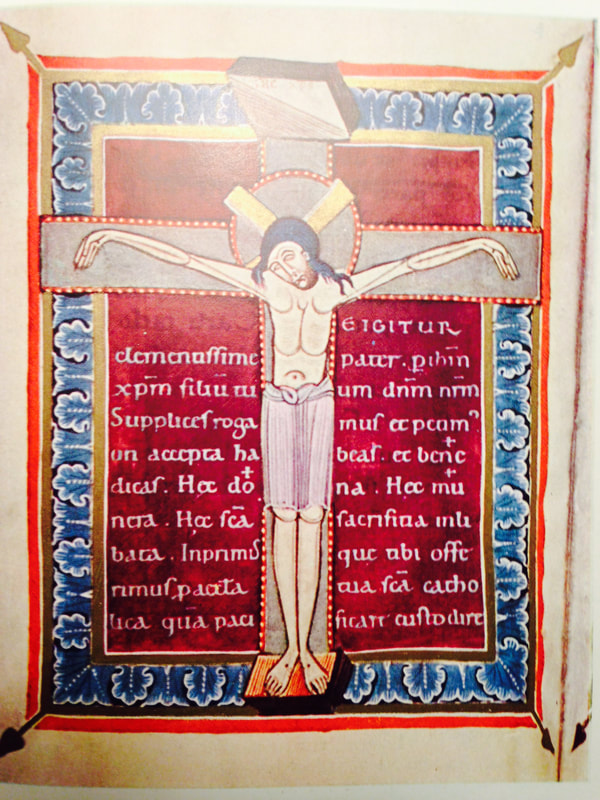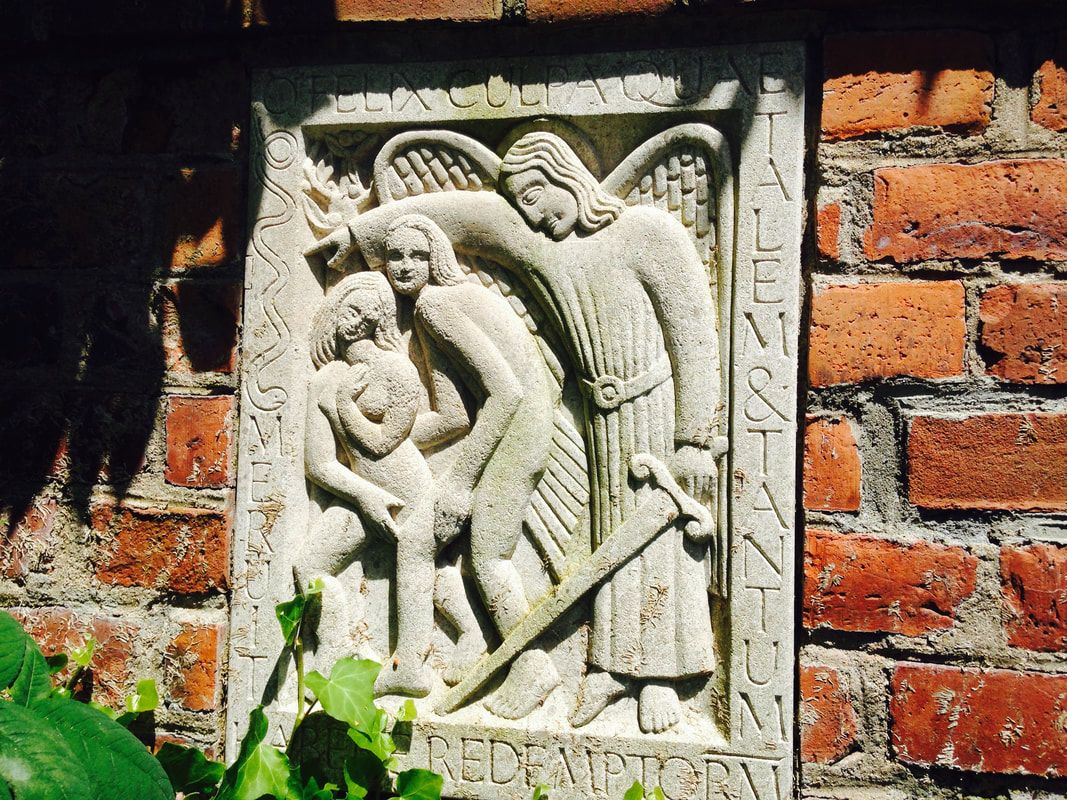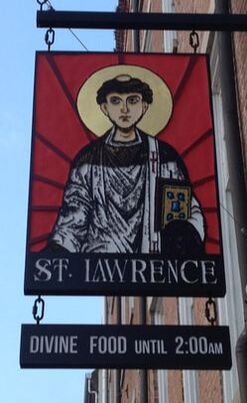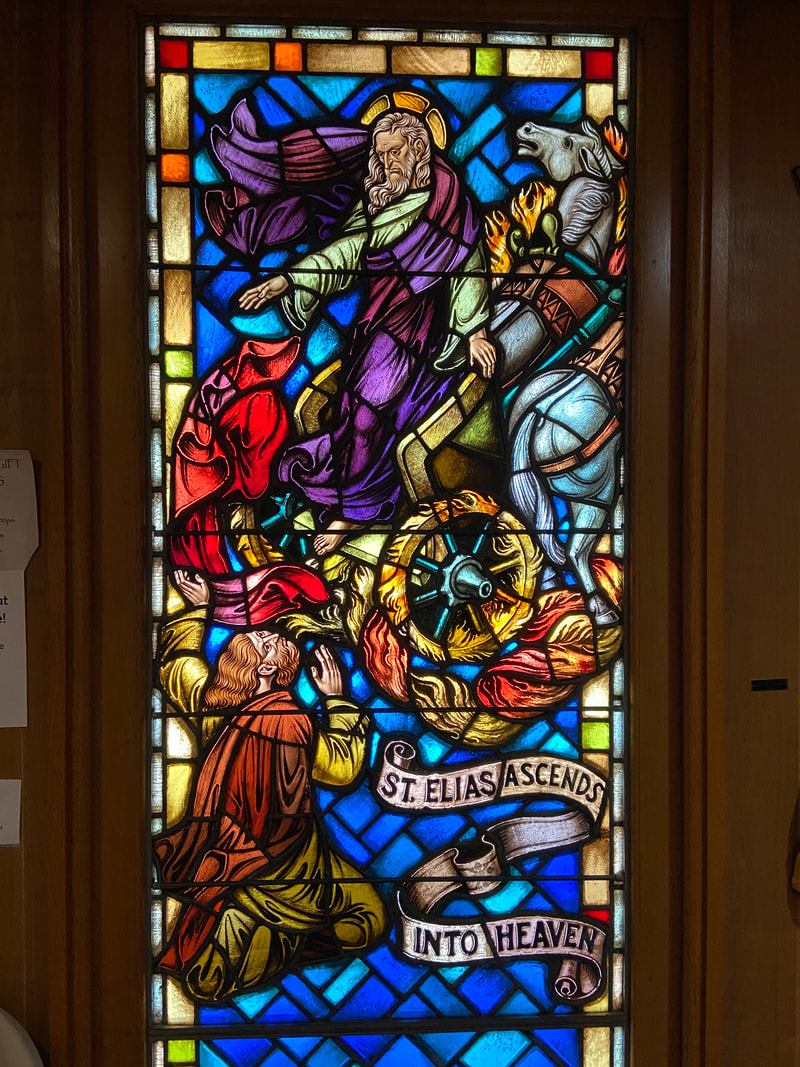Latin Catholic Tradition
This image of Christ on the Cross dates from the latter half of the 11th century ~ when our patron saint, St. Bernard of Clairvaux, was born. The image forms the initial "T" of the Eucharistic Prayer beginning "Te igitur, clementissime Pater" ~ the ancient and venerable Roman Canon. The text on the image reads: "Te igitur, clementissime Pater, per Jesum Christum Filium tuum Dominum nostrum, supplices rogamus, ac petimus, uti accepta habeas, et benedicas, haec dona, haec munera, haec sancta sacrificia illibata, in primis, quae tibi offerimus pro Ecclesia tua sancta catholica: quam pacificare, custodire...." "We therefore, humbly pray and beseech Thee, most merciful Father, through Jesus Christ, Thy Son, our Lord, that Thou wouldst vouchsafe to accept and bless these gifts, these presents, this holy Victim without blemish, which in the first place we offer Thee for Thy holy Catholic Church; vouchsafe to preserve and govern her...."
Saint Jerome
Saint Jerome, one of the great Latin Fathers of the Church, gave piquant and very personal expression to the faith in his many letters. From Epistola 107 (Ad Laetam de institutione filiae):
"Cum avum viderit, in pectus eius transiliat, et colo pendeat, nolenti alleluia decantet." "When she sees her grandfather she should leap upon his breast, hold him around the neck, and whether he is willing or not, sing Alleluia to him." (!) For this darling seven-year old granddaughter, Jerome prescribed: "discat memoriter psalterium" ~ "let her learn the Psalter by heart."
"Cum avum viderit, in pectus eius transiliat, et colo pendeat, nolenti alleluia decantet." "When she sees her grandfather she should leap upon his breast, hold him around the neck, and whether he is willing or not, sing Alleluia to him." (!) For this darling seven-year old granddaughter, Jerome prescribed: "discat memoriter psalterium" ~ "let her learn the Psalter by heart."
O Felix Culpa
Latin Catholic tradition in our own back yard ! This relief depicting the expulsion of Adam and Eve from the Garden of Eden (vide the serpent curlicued in the left border) adorns the beautiful gardens of the Wethersfield estate in Amenia, New York. It bears a verse from the Exultet, sung at the Easter Vigil Mass: "O felix culpa, quae talem & tantum meruit habere Redemptorem !"
(O happy fault, that merited to possess such and so great a Redeemer !) This wonderful and seemingly paradoxical notion delves deep into the mystery of our faith, affirming God's power to draw good out of evil. The idea is developed in the English carol Adam Lay Ybounden: Ne had the appil take ben, ne hadde Never our Lady a ben hevene quene. Blessed be the time that appil take was. Therefore we moun singen: Deo Gratias ! |
Saint Lawrence
Anima Christi
Anima Christi, sanctifica me. Corpus Christi, salva me. Sanguis Christi, inebria me. Aqua lateris Christi, lava me. Passio Christi, conforta me.
O bone Jesu, exaudi me. Intra tua vulnera absconde me. Ne permittas me separari a te. Ab hoste maligno defende me. In hora mortis meae voca me;
et jube me venire ad te, et cum Sanctis tuis laudem te, in saecula saeculorum. Amen.
Soul of Christ, sanctify me. Body of Christ, save me. Blood of Christ inebriate me. Water from the side of Christ, wash me. Passion of Christ, strengthen me.
O good Jesu, hear me. Within your wounds hide me. Separated from you let me never be. From the evil one protect me. At the hour of my death, call me;
and bid me to come to you, that with your saints I may be praising you forever and ever. Amen.
O bone Jesu, exaudi me. Intra tua vulnera absconde me. Ne permittas me separari a te. Ab hoste maligno defende me. In hora mortis meae voca me;
et jube me venire ad te, et cum Sanctis tuis laudem te, in saecula saeculorum. Amen.
Soul of Christ, sanctify me. Body of Christ, save me. Blood of Christ inebriate me. Water from the side of Christ, wash me. Passion of Christ, strengthen me.
O good Jesu, hear me. Within your wounds hide me. Separated from you let me never be. From the evil one protect me. At the hour of my death, call me;
and bid me to come to you, that with your saints I may be praising you forever and ever. Amen.
Saint Ambrose
Nescit tarda molimina Sancti Spiritus gratia. ~ The grace of the Holy Spirit does not undertake things sluggishly.
From a Homily of St Ambrose, Bishop of Milan, appointed for Matins on Ember Friday in Advent
From a Homily of St Ambrose, Bishop of Milan, appointed for Matins on Ember Friday in Advent
Saint Bernard of Clairvaux
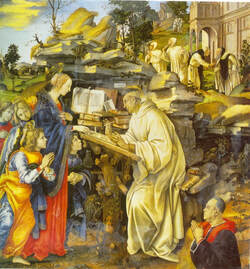
Saint Bernard of Clairvaux with the Virgin Mary, painted ca. 1486 by
Filipino Lippi. The open book contains the words "Missus est Angelus Gabriel a Deo," from St. Bernard's Sermon on the Annunciation.
St. Edmund of Abindon
Disce quasi semper victurus; vive quasi cras moriturus. Learn as if you will live forever; live as though you would die tomorrow.
St. Elias
The prophet Elias, in Elisha's presence, ascending to heaven in the Chariot of Fire. This stained glass window is in the National Shrine of Our Lady of Mount Carmel in Middletown, NY.
The Shrine is operated by the Carmelite Province of St. Elias, established by Irish Carmelites -- of the Ordo Fratrum Beatae Virginis Mariae de Monte Carmelo -- in New York in the late 19th century. The lovely Shrine Chapel is built in the shape of a tongue of fire. Among the saints' relics there is the jawbone of St. Simon Stock, founder of the Carmelite order ca. 1300. The Chapel also contains a small side altar baldachino, with a statue of the Madonna and Christ Child, bearing the inscription "Tu soror nostri es." Consonant with their profession as Brothers
of the Virgin Mary, the Carmelites venerate Mary as Mater et soror -- "our Mother and sister."
R. Factum est, dum tolleret Dominus Eliam per turbinem in caelum, Eliseus clamabat, dicens: Pater mi, pater mi, currus Israel, et auriga eius.
V. Cumque pergerent, et incedentes sermocinarentur, ecce currus igneus et equi ignei diviserunt utrumque, et ascendit Elias per turbinem in caelum.
The Shrine is operated by the Carmelite Province of St. Elias, established by Irish Carmelites -- of the Ordo Fratrum Beatae Virginis Mariae de Monte Carmelo -- in New York in the late 19th century. The lovely Shrine Chapel is built in the shape of a tongue of fire. Among the saints' relics there is the jawbone of St. Simon Stock, founder of the Carmelite order ca. 1300. The Chapel also contains a small side altar baldachino, with a statue of the Madonna and Christ Child, bearing the inscription "Tu soror nostri es." Consonant with their profession as Brothers
of the Virgin Mary, the Carmelites venerate Mary as Mater et soror -- "our Mother and sister."
R. Factum est, dum tolleret Dominus Eliam per turbinem in caelum, Eliseus clamabat, dicens: Pater mi, pater mi, currus Israel, et auriga eius.
V. Cumque pergerent, et incedentes sermocinarentur, ecce currus igneus et equi ignei diviserunt utrumque, et ascendit Elias per turbinem in caelum.
What God Needed to Become Man
"God needed two things in order to become man: the Virgin's womb and the Latin language." Paul Claudel
Saint Columba on Monastic Life
That I might bless the Lord who conserves all --
Heaven with its countless bright orders, land, strand and flood,
That I might search the books all that would be good for any soul;
At times kneeling to beloved Heaven at times psalm-singing;
At times contemplating the King of Heaven, Holy the Chief;
At times at work without compulsion, this would be delightful;
At times picking the kelp from the rocks at times fishing
At times giving food to the poor at times in a carcair (solitary cell).
Heaven with its countless bright orders, land, strand and flood,
That I might search the books all that would be good for any soul;
At times kneeling to beloved Heaven at times psalm-singing;
At times contemplating the King of Heaven, Holy the Chief;
At times at work without compulsion, this would be delightful;
At times picking the kelp from the rocks at times fishing
At times giving food to the poor at times in a carcair (solitary cell).
An Unlikely Ally
Confucius says: "The practice of humanity comes down to this: Tame the self and restore the rites."
